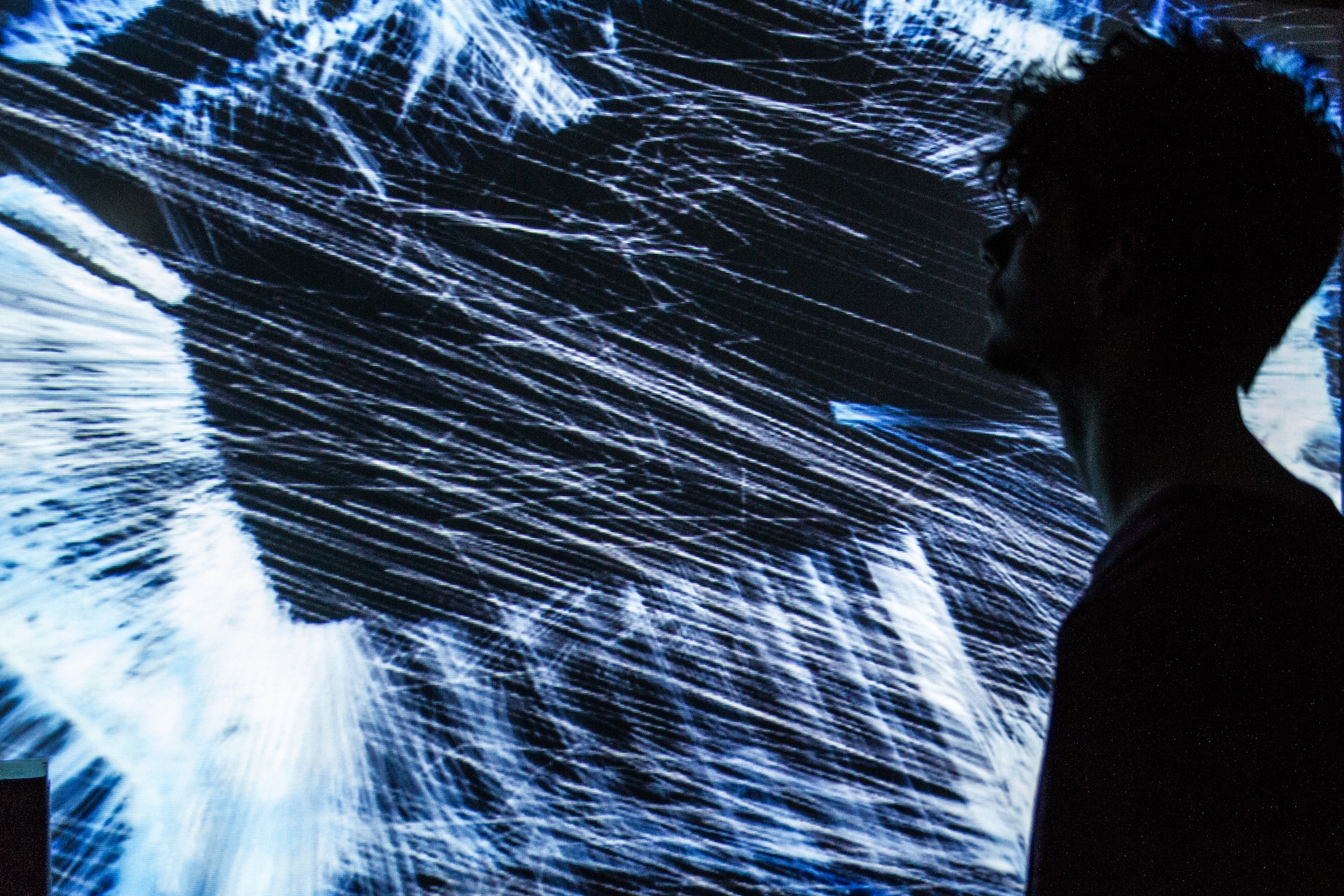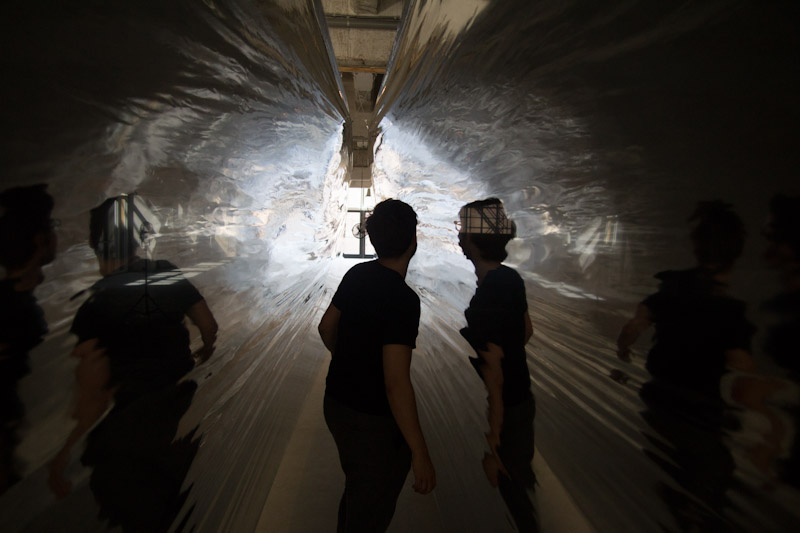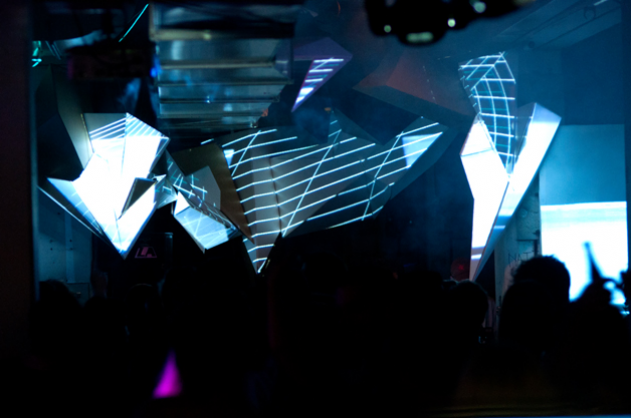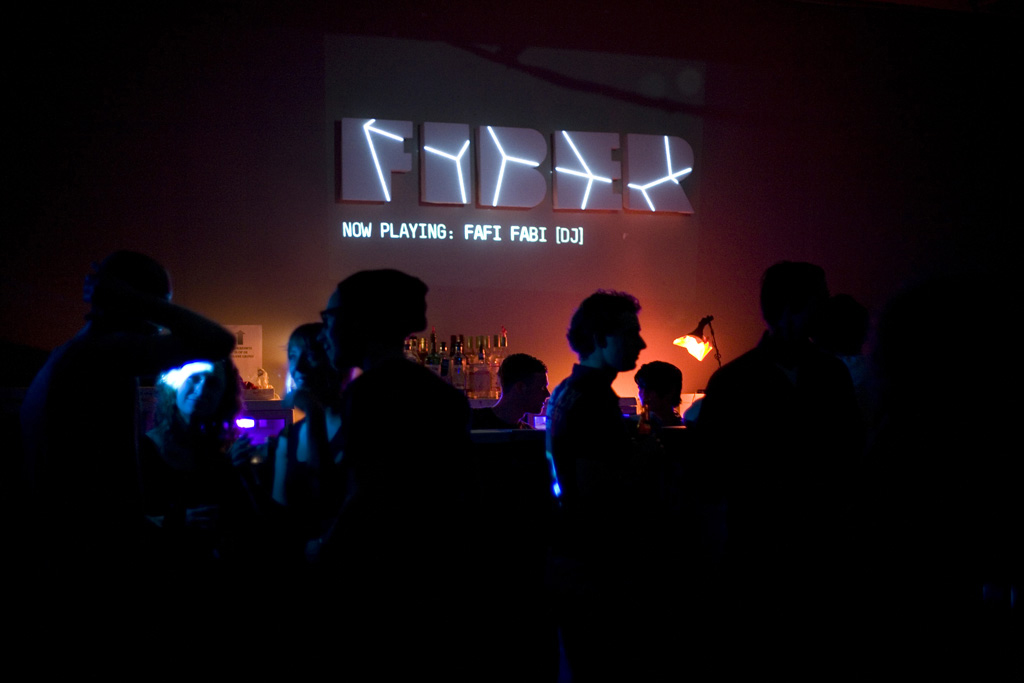Get Familiar: Amsterdam’s FIBER Festival
XLR8R talks to the organizers behind the groundbreaking electronic-arts-and-music fest.

Get Familiar: Amsterdam’s FIBER Festival
XLR8R talks to the organizers behind the groundbreaking electronic-arts-and-music fest.

If you are still trying to figure out what to do this weekend, and if you are at all interested in cutting-edge music, arts and culture—and if you’re reading XLR8R, its a safe bet you are—you could do far worse than opting for the third edition of Amsterdam’s FIBER festival. The two-day event, held on May 15 and 16, is focused on “the intersection of audiovisual art, digital culture and electronic music”—and to find out what it’s all about we posed a few questions to FIBER director Jarl Schulp, the festival’s club and visual-sceneography curator Luuk Meuffels, and Arvan Rietveld, the owner of Field Records, an Amsterdam-based label which collaborates in FIBER’s production. And if you if you need yet more convincing, check out the festival’s very cool promotional trailer here.
For those of us who have never attended FIBER in past years ould you explain what the festival is all about?
Schulp: FIBER is an Amsterdam-based organization with a strong focus on the synesthesia between sound, the moving image and emerging technology. The festival also explores the artistic potentials of code, software and technology and critically questions their influence on our culture and own perception. It’s a meeting place for creators and admirers of a wide variety of audiovisual and performance art and design.
We founded FIBER in 2010 with a group of like-minded audiovisual artists, designers, and communication/web experts from Utrecht and Amsterdam. Our goal was creating a meeting place for young creators of immersive and atmospheric electronic music and mediated spatial experiences. The worlds of deep and adventurous club music and the visual arts are often separated, but we saw strong connections also presented by renowned European festivals with bigger names. We felt the need for a space for up-and-coming creators—those studying or at the start of their careers—to perform in a professional environment and open up their knowledge to others. We thought of a way to bring them together and this turned out to be a festival that combined performance, stage, and a “lab” environment.
Now, almost 5 years later, we’re active in the curation of events, exhibitions, a regular music podcast, and the support of artists across many disciplines. And with this year’s FIBER Festival, we return to the beginning of our story.
Can you talk a bit about the ethos of Field Records, and describe the collaboration, along with how Field’s ethos that relates to the direction of the festival?
Rietveld: Since 2008, Field Records has focused on publishing unique electronic music from a wide variety of artists. Based on the principles of minimalism and modesty, we started the label as a means of providing a platform for Dutch artists, but as time passed we made the step to broaden our horizons and started to invite a selection of global artists for various concepts and formats.
Schulp: We both have a strong interest in the artistic and cinematographic side of electronic music and performative art, always looking for clear concepts and a strong synergy between sonic and visual worlds.
Rietveld: In a way, it’s a choice of aesthetics and—maybe a bit harder to explain—a certain feeling about music. We’re not going for a one-dimensional sound or image. Both organizations seek a much more layered experience, in which an artist experiments with time, space, form and the actual structure of sound.

Schulp: Techno is a common ground, but we also have a great love for ambient. It’s interesting to find this shared interest in a certain grainy & decayed sound, through collaboration with the same local artists. For instance, FIBER has worked together with sound artist and techno producer Robin Koek, who combines field recordings and digitally processed signals. Robin is also one half of techno duo Artefakt, who released most of their music on Rietveld’s Field Records. Another example: A part of the FIBER members are visual artists operating within the collective DEFRAME. They VJed during various Field Records nights in Amsterdam. Without really working together before, we already shared the same feeling about certain aesthetics.
Rietveld: For me this clearly demonstrates that we both present and support a local scene of artists, DJs and producers.
Meuffels: For the upcoming FIBER Festival, we decided to take the musical collaboration in a different direction. The first idea that comes to mind is a dancefloor-oriented line-up. But after we started talking about what we were really missing in club evenings nowadays, we found out it was the “old” and adventurous chill-out space. Throughout the ’90s and until eight or ten years ago, this type of room was an important part of the night experience. Music styles as IDM, chill-out, and downtempo electronics were blended together by highly versatile DJs in an amazing and unpredicted selection. You could discover new music and at the same time have a conversation with someone you just met at the party. As FIBER, we think this is a very important experience we can offer our crowd.
Rietveld: Additionally, the festival’s Field Surrounding series envisages an authentic approach to sound by delivering mixtapes thriving on artistic freedom and quality. This element represent a more open, free-form approach towards the heritage of today’s electronic music and artists, and we believe it is also important to represent these roots in a physical setting. FIBER now offers the perfect setting to us.
There are so many talented and hybrid artists and musicians who are pushing the boundaries of space, for instance, or the notion of an instrument.
Why did FIBER originally choose to produce a festival that fused electronic music and art, rather than just a straight-ahead music fest?
Schulp: As mentioned earlier, we have always been drawn to the intersection of art, music and emerging technology. There are so many talented and hybrid artists and musicians who are pushing the boundaries of space, for instance, or the notion of an instrument. What happens to our senses when we’re entering a performative space that’s not purely based on sound? We’re looking for these types of performances, installations, live sets, websites…you name it. And a festival is a powerful tool to bring together those artists who cross the borders of their own practice.
Rietveld: I connect with this idea. Diversity adds to creative richness and offers a much wider canvas for experimentation. Personally, I always consider music in a much broader context to have the right impact. Think of the atmosphere of the location, the acoustics, light design, visuals and how these elements are brought together in a spatial composition. The same can be said for artists that create media-art installation.
Schulp: FIBER is looking for that particular meeting point. So is Field Records in its own way.
Going into the initial 2011 edition, were you prepared for how much work this was going to be?
Schulp: We came unprepared—literally, because none of us had ever organized a festival. But all of us had some experiences in a certain domain. I have a background in graphic and information design for art exhibitions, websites and promotional campaigns; Luuk has a background in VJing, stage design and media design. We brought the skills of the group team together, got support from a broader network of befriended artists and companies and collectively made it to the finish.

Back then, I never thought about the amount of work that needed to be done. The energy of the collective goal balanced it all out. Looking back at the first edition I’m still surprised how we managed to translate a digital process —co-creating the festival plans online in Google Wave (RIP)—into a physical one, namely producing the actual festival.
Was FIBER a success from the start?
Schulp: In general, yes it was. Of course we have our ups, downs and demons, but this is the way things go. You start something from the heart—and further down the road, challenges in continuity, revenue and collaborations surface. But this is pretty normal for young organizations, I think.
FIBER had hiatus for a few years, in 2013 and 2014. Why was that?
Schulp: After the 2012 edition, we all had the feeling we needed time off from the festival format. Diving back into funding applications, the creation of the artistic program, and kick-starting the production didn’t feel like the right thing to do. Furthermore, we all felt we needed a better organization structure to survive. FIBER was brought to life with the goal of organizing a festival, but clearly missed a solid organization. There was simply no time for it.
So after 2.5 years of a festival roller-coaster, we took a break and started thinking of smaller events, which could also provide more space to experiment with formats, artists and partners. This hiatus made it possible to work on a small exhibition at the Netherlands Media Art Institute and afterwards start our new event series called Coded Matter(s). By abandoning the festival for a while we had the opportunity to slowly build a new direction, artistic output and take the organization to a new level.
“Is it still possible to talk about a separate ‘digital culture’ nowadays, or is this just becoming ‘culture’?”
How would you describe “digital culture”?
Schulp: Good question, because the term itself is becoming quite problematic, I think. We use “digital culture” as a way to describe the (re-)creation of culture through computational processes and to describe an aesthetic created with digital means. But as the influence of code, automated software and digital networks on our society is expanding rapidly, everything seems to become connected and digital in a way. A major part of the production and distribution of art, design and music is done with digital means. And look at the dawn of the Internet of Things, where all objects, cars, houses, fridges and mobile devices are communicating with each other. Is it still possible to talk about a separate “digital culture” nowadays, or is this just becoming “culture”? For us “digital culture” mostly underlines our exploration of the influence of digitality on for instance art, music, literature and culture in general.
Do you find it advantageous to be doing this event in Amsterdam, which is a city that has a reputation supporting the arts?
Schulp: We’re grateful to be supported by local and national funding partners, like for instance The Amsterdam Fund For The Arts. For us this makes it possible to work at the intersection of art and music—and to take some risks. We still need to craft a good balance between experimentation and selling tickets, but with this kind of support it’s possible to do proper research, critically address artistic or technological developments, shape a tailor-made program and present up-and-coming names.
Rietveld: Speaking from our perspective, Amsterdam is acting as a magnet for electronic dance music. Just look at the rise of the Amsterdam Dance Event. During these five days, the city hosts a huge number of club nights, talks, and meet-ups around town. If you start going out as a young resident of the city, it’s possible to see all the big names in a few years. This is also the problem; people expect big names here. It is quite a hassle to promote more experimental programs, because the crowd looks out for big names.
Schulp: With FIBER, we try to balance this and combine influential DJs, performers and audiovisual artists from a niche scene with local names. It is interesting to see there’s also a counter movement, like the ANONYMOUS club night by Viral Radio and Sonic Acts, which took place in Amsterdam last year. Inspired by the ANONYMOUS hacker-movement all the identities of the performers are kept…well…ANONYMOUS. It’s a clear statement against the “headliners culture,” The lineup was presented like this: Anonymous (live), Anonymous (live), Anonymous (live), Anonymous (dj), Anonymous (dj), Anonymous (dj), Anonymous (kunst) and Anonymous (design). The next day the organisation released the line-up and among the great line-up where names like Laurel Halo and Kuedo.

What kind of crowd do you get at FIBER and Field Events? I’m assuming that it’s a bit different than the crowd at, say, Defqon 1.
Schulp: First of all, we’re not organizing massive events, so we don’t attract a crowd who’s looking for big names. Our visitors are searching for a different experience and some of them are out to be surprised by unknown artists or musicians. Plus, we attract those music lovers who are in for a unique personality or niche name, like the live set by Convextion or DJ set by Neel.
Next to this, we’re a maker’s festival, which functions as a lab and meeting place. We’re attracting audiovisual artists, VJs, D’, producers, designers, creative coders, instrument builders and—not to forget writers and researchers with an interest in critical reflection on these area’s.
Rietveld: (Electronic) music lovers, people who look at the boundaries and like to experience something different. Therefore, or because of that, our crowd is generally also a bit older. Maybe that doesn’t sound positive, but it actually is.
This edition is subtitled The Subterranean: Exploring Networked Tools and Matter. Can you elaborate on that a bit?
Schulp: This year’s theme, The Subterranean—Exploring Networked Tools and Matter—investigates artistic practices that create, navigate and excavate a hidden digital landscape. For us, The Subterranean is a metaphor for the vast network of innumerable computers, cables, servers, robotics and algorithms. We use it to paint a picture of a technological layer that is mediating our perception of the world.
Reitveld: To me, the Subterranean means darkness, exploring different territories. It’s the perfect setting to create an abstract, moody atmosphere for the people who like to be inspired and/or surprised.
Are there any artists who you are particularly excited to see/hear at the upcoming edition?
Schulp: That’s a tough one. The installations, performances or DJ sets are, for me, linked together through the festival theme. We’re telling one story here, with different angles and chapters. Every part of this becomes relevant and exciting in its own way, and many connections can be found. The modular synth set by London Modular Alliance—who will perform new parts based on our The Subterranean theme—is in a way connected to the visual coding language vvvv used in the workshop by Berlin-based Christian Mio Loclair. Both are patching cables to route complex systems with unforeseen outcomes. I like these often “hidden” connections within the program.
Also special—we have two performance premieres this year: the AV-performances Divergence by Zeno van de Broek and False Awakening by Microseq. Both guys are from the Netherlands and have worked on their pieces for a long time.
What I’m also looking forward to is bringing all these wonderful artists, visitors and of course our FIBER team, together in the city of Amsterdam. The off-stage part of the festival, where there’s an exchange of ideas and knowledge and new friends are made, is for me just as important and inspiring as the artistic program.
Meuffels: I’m pretty much focused on the club night, but can’t really pick a favorite from that part of the program. The artists in the club’s main room all have different qualities which will make a great musical adventure altogether. That’s what makes this club lineup strong I think; they’re all equal headliners with their own role within the musical story of the night.
Also have to say I’m very curious about the way the chill-out room will turn out in general. I really miss this kind of program in today’s clubbing landscape.
Rietveld: For me, Convextion and Felix K always bring something unique. They rarely play in the Netherlands, so this is a great opportunity. I also heard a lot about London Modular Alliance.
And what’s next for FIBER? Onwards and upwards?
Schulp: After the festival, we return to our ongoing event series Coded Matter(s). These events are mostly compact evening program with an unforeseen mixture of showcases, presentations, performances and specialized workshops. With CM we’re exploring how code, software and complex systems influence art, design and music. We did one event on the creation of audiovisual instruments with the use of creative coding platforms, and the next one in June is all about the impact of new resolutions on visual culture.
Coded Matter(s) now forms a solid research backbone for the next festival theme, program and partnerships. We’re already conceptualizing a bigger event at the end of the year and this is, in a way, also connected to the preparation for a new festival edition. When this new FIBER Festival will happen is not set. But I have a few scenarios in mind. More important is a longer preparation time to come up with unique collaborations, new performances, adventurous places and to become a strong and valuable hub within our international network.
Meuffels: We’ll continue our podcast series with mixes from artists we feel musically connected with. We don’t just stick to one genre, but try to walk a path through these different styles that makes a great musical adventure.

